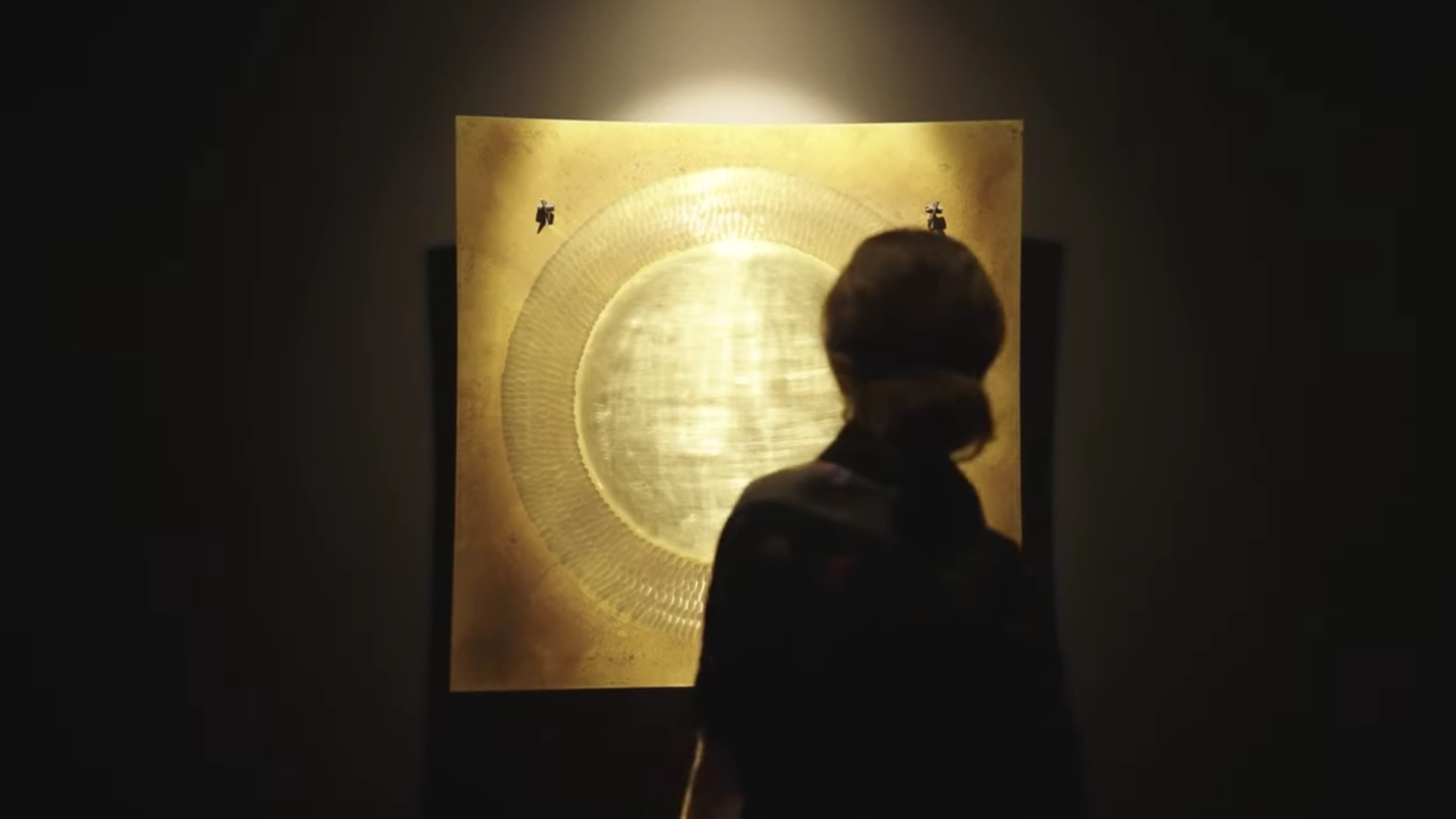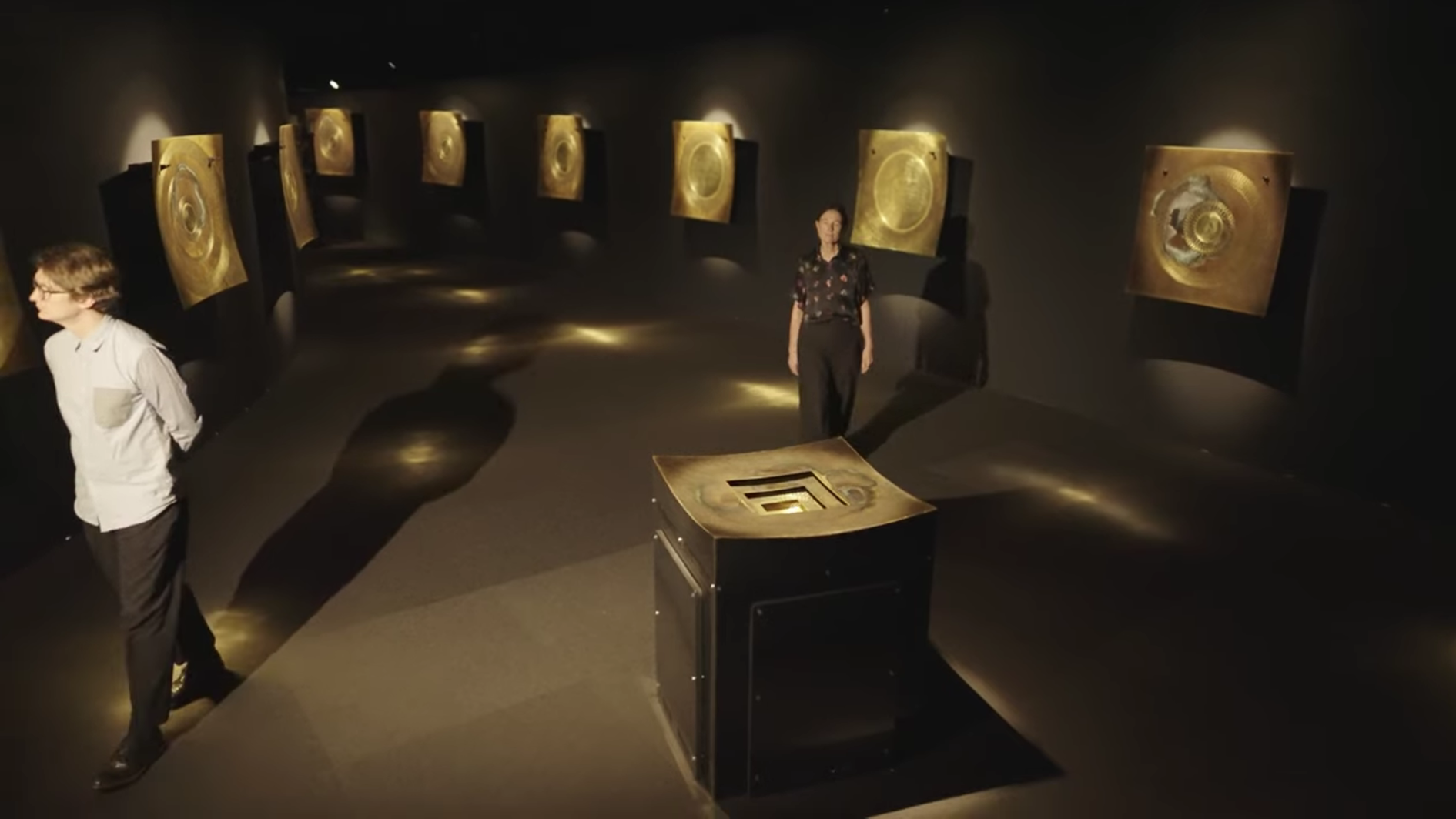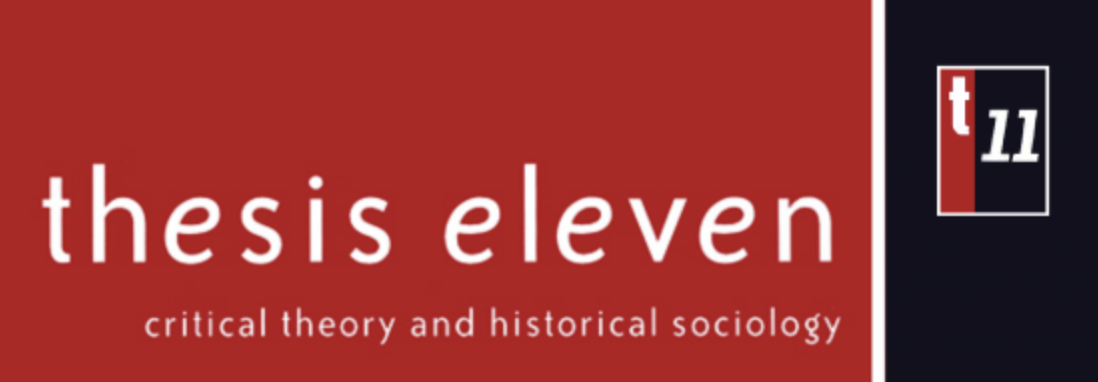



Revivification is the latest experimental exhibition at the Art Gallery of Western Australia,
featuring a particularly unusual central work—a brain grown in a lab.
Predominantly, the exhibition is a sound-based collaborative installation by
artists Guy Ben-Ary, Nathan Thompson and Matt Gingold and neuroscientist Stuart
Hodgetts. Revivification revolves around the "in-vitro brain" of late
composer Alvin Lucier, who passed in 2021. This external brain was grown from
converting a blood sample from Lucier, provided before his death into stem
cells. These stem cells were then altered further to become cerebral organoids,
which are ‘three-dimensional structures that resemble a developing human brain’
[1]. This brain is then connected via computer technology to twenty curved brass
plates that respond to the neural activity in the brain to generate sound. When
the brain signals pulse, the brass plates are struck, activating a cacophony of
strange and beautiful sounds. The themes of Revivification are those of immortalisation, biological agency and the intersection between
art and science. Alvin Lucier’s career as a composer was experimental and this
exhibition acts as a posthumous extension of that career. Lucier was known for
performances where he would wear EEG electrodes to translate his brain activity
to live instruments. Revivification can be seen as a stripping away to the essentials of what made those
performances so intriguing, instruments relaying brain activity into sound in
real time. To tease out some key themes of Revivification,
I will be looking at Daisy Dunn’s ‘The strange death of the art school’ (2021)
alongside perspectives from New Materialist theory to explore the material
approach of Revivification and the
themes of agency present within the work.
Daisy Dunn’s ‘The strange death of the art school’ investigates the shift from experimentation and practice-led research within art schools to a more institutionalised curriculum focused on written assessments and over justification of bland conceptual art, all of which due to the institutional evolution from ‘art school’ to a more formal university status. [2] Dunn critiques the relatively recently achieved university status of art schools by stating that the shift has made art school about producing those who can contribute economically after completing their degree. This creates a cycle of teaching that encourages young artists to impersonate already successful artists, such as Dunn’s example of the Young British Artists. These changes are also a result of continuous funding cuts from arts education, which make it harder for art schools to justify investing into projects without guaranteed financial benefit. As a result, Dunn argues that the art school upon gaining university status has become less about pushing artistic boundaries, and instead about producing artists fluent in faux-academic justifications for art making, with little room for experimentation or genuine creative risk-taking. However, Revivification stands in direct opposition to many critiques made by Dunn. Experimentation and process-based exploration are key to this exhibition. The artists’ privilege process and materiality throughout the making and exhibiting of the work, a trait that Dunn suggests is lost in contemporary art education. Revivification suggests that there are still spaces in which art can emerge through curiosity despite institutional and economic pressures to produce work that is valuable.
This drive for ingenuity on behalf of the artists could be because of the artists’ connection to SymbioticA. Many, if not all, the artists that worked on Revivification are currently or have previously worked as a part of SymbioticA. SymbioticA is the world’s first bio arts laboratory, pioneering the intersection between art, science and technology. Revivification lives in this intersection, using living matter as a material in the work. Their work is a clear reflection of the institute’s ethos of material experimentation and ethical inquiry. Prior to 2024 SymbioticA offered a space for projects such as Revivification to take place, providing support for a niche industry within a broader art context. Throughout the 2020s SymbioticA has struggled with a lack of institutional funding and was slated to close in June of 2024. However, information regarding the closure remains unclear and no updates have been publicly provided by UWA or SymbioticA. Regardless, the institution has been faced with severe budget cuts from UWA, who have stated the reason to be to prioritise core teaching and research areas [3]. Although Revivification resists the pressures that led to SymbioticA’s decline, its existence within Western Australia’s state art gallery suggests that bio art is worth supporting and a reminder of the need for experimental institutions like SymbioticA.
Revivification can also be seen through a New Materialist perspective via the use of live materials, such as the brain organoid central to the exhibition. New Materialism is a theoretical approach to the world that rethinks the relationship between matter and humans, questioning the idea that humans are the only beings with agency [4]. It emphasises the role of agency in art making, suggesting a way of working where the artist is not dictating the materials, but rather is in co-collaboration with them. This idea of co-collaboration between maker and materials is in opposition to the early Enlightenment’s anthropocentric view of the world, a view that sees humans as the only beings with agency and those who shape the world [5]. New materialism calls for a shift towards process rather than pre-defined outcomes, a sentiment also present in Barbara Bolt’s Practise as Research (2010). In this book, Bolt argues that knowledge emerges in art making through materials, time and process. Bolt introduces the concept of ‘material thinking’—a theory in which material is not simply passive matter waiting to be acted upon by a being with agency (a human), but rather a participant in the production of knowledge [6]. These New Materialist perspectives offer a new framework in which Revivification can be viewed through. At the core of this exhibition is the brain organoid, a living material that has agency over the sounds emanating from the brass plates surrounding the viewer. The artists engage with these materials as collaborators, providing a framework from which the brain grows and produces sound based on the signals being emitted. Unpredictability is embraced in this show; rather than providing a set composition, the brain organoid has agency over the sounds being made. Revivification aligns with New Materialist thought, due to the artists providing an opportunity for materials to have agency over the work. The exhibition stands in contrast to others, where traditional exhibition outcomes are controlled and rehearsed. Here, outcomes are able to emerge unpredictably. The work in Revivification is never fixed; it is living and changing constantly, shifting throughout the process of making. It offers a rare experience for viewers in a traditional gallery space, one shaped by the behaviour of a living organism rather than the artist. In this, the exhibition exemplifies the kind of thinking that Bolt deems as New Materialist.
When arriving at AGWA, Revivification hardly makes its presence known. Instead of a large inviting doorway like typical AGWA exhibitions, viewers enter through dark and narrow tunnel made from felt soundproofing material, ensuring that all sound is trapped inside. When your eyes adjust and navigate the curvature of the exhibition space, you are surrounded by brass plates lining the walls. Walking further in, the sound produced by the brass plates seems to follow you, luring you into the back of the tunnel where the brain is staged. The brass box that houses the brain has an opening for viewers to peer through, and note the organoid is small, no bigger than a fifty-cent coin. Against the back wall are seats where viewers can sit while listening to the sounds being made. When first visiting this exhibition, I felt as if the composer was trying to escape the confines of his petri dish, banging on the brass plates like jail bars. However, when visiting again I appreciated the beauty in listening to these different and at some points awkward noises coming from such ornate brass plates that could be sculptural objects displayed alone in a different exhibition. The brain was shaping my experience, making noises that were unpredictable but interesting in that skill. It prompts viewers to question the consciousness of the brain organoid—if the brain is still growing and learning, at what point does it know what it is doing? Could it learn from the sounds being made by itself? Revivification offers a unique experience for the visitor, one that suggests death is not the end of creativity.
This exhibition highlights the importance of supporting the bio art industry, due to the distinctive outcomes that shows of this depth can produce. Revivification can be seen as an extension of New Materialist thought. We see this in the choice to work with live materials as collaborators, where emphasis is placed on the materials that control the show. The exhibition demonstrates what possibilities can emerge from a creative practice that deviates from traditional institutional structures of art making, and the crucial need to fund alternative institutions like SymbioticA. It chooses to prioritise experimentation and process rather than predictability and justification. The result is a singular experience within an institution of AGWA’s stature, successfully creating a space for emotional response and ethical questions. Revivification is a compelling example of how risk-taking, material-led art can still happen in mainstream galleries such as AGWA.
Footnotes:
1. Art Gallery of Western Australia. 2025. "Revivification." AGWA. https://artgallery.wa.gov.au/whats-on/exhibitions/revivification/
2. Dunn, Daisy. 2021. ‘The strange death of the art school.’ Engelsberg Ideas. https://engelsbergideas.com/notebook/the-strange-death-of-the-art-school/.
3. Amant, Alisyn. 2023. ‘Bio Artists Face an Uncertain Future.’ Hyperallergic. https://hyperallergic.com/862162/bio-artists-face-an-uncertain-future/
4. Bolt, Barbara. 2013. Carnal knowledge: Towards a ‘new materialism’ through the arts. 1st ed. London England: I.B. Tauris & Co. Ltd.
5. Ibid.
6. Bolt, Barbara. 2010. Practice as research: Approaches to creative arts enquiry. 1st ed. London England: I.B. Tauris & Co. Ltd.
Images of Revivification at the Art Gallery of Western Australia, courtesy of the arts and AGWA.
Daisy Dunn’s ‘The strange death of the art school’ investigates the shift from experimentation and practice-led research within art schools to a more institutionalised curriculum focused on written assessments and over justification of bland conceptual art, all of which due to the institutional evolution from ‘art school’ to a more formal university status. [2] Dunn critiques the relatively recently achieved university status of art schools by stating that the shift has made art school about producing those who can contribute economically after completing their degree. This creates a cycle of teaching that encourages young artists to impersonate already successful artists, such as Dunn’s example of the Young British Artists. These changes are also a result of continuous funding cuts from arts education, which make it harder for art schools to justify investing into projects without guaranteed financial benefit. As a result, Dunn argues that the art school upon gaining university status has become less about pushing artistic boundaries, and instead about producing artists fluent in faux-academic justifications for art making, with little room for experimentation or genuine creative risk-taking. However, Revivification stands in direct opposition to many critiques made by Dunn. Experimentation and process-based exploration are key to this exhibition. The artists’ privilege process and materiality throughout the making and exhibiting of the work, a trait that Dunn suggests is lost in contemporary art education. Revivification suggests that there are still spaces in which art can emerge through curiosity despite institutional and economic pressures to produce work that is valuable.
This drive for ingenuity on behalf of the artists could be because of the artists’ connection to SymbioticA. Many, if not all, the artists that worked on Revivification are currently or have previously worked as a part of SymbioticA. SymbioticA is the world’s first bio arts laboratory, pioneering the intersection between art, science and technology. Revivification lives in this intersection, using living matter as a material in the work. Their work is a clear reflection of the institute’s ethos of material experimentation and ethical inquiry. Prior to 2024 SymbioticA offered a space for projects such as Revivification to take place, providing support for a niche industry within a broader art context. Throughout the 2020s SymbioticA has struggled with a lack of institutional funding and was slated to close in June of 2024. However, information regarding the closure remains unclear and no updates have been publicly provided by UWA or SymbioticA. Regardless, the institution has been faced with severe budget cuts from UWA, who have stated the reason to be to prioritise core teaching and research areas [3]. Although Revivification resists the pressures that led to SymbioticA’s decline, its existence within Western Australia’s state art gallery suggests that bio art is worth supporting and a reminder of the need for experimental institutions like SymbioticA.
Revivification can also be seen through a New Materialist perspective via the use of live materials, such as the brain organoid central to the exhibition. New Materialism is a theoretical approach to the world that rethinks the relationship between matter and humans, questioning the idea that humans are the only beings with agency [4]. It emphasises the role of agency in art making, suggesting a way of working where the artist is not dictating the materials, but rather is in co-collaboration with them. This idea of co-collaboration between maker and materials is in opposition to the early Enlightenment’s anthropocentric view of the world, a view that sees humans as the only beings with agency and those who shape the world [5]. New materialism calls for a shift towards process rather than pre-defined outcomes, a sentiment also present in Barbara Bolt’s Practise as Research (2010). In this book, Bolt argues that knowledge emerges in art making through materials, time and process. Bolt introduces the concept of ‘material thinking’—a theory in which material is not simply passive matter waiting to be acted upon by a being with agency (a human), but rather a participant in the production of knowledge [6]. These New Materialist perspectives offer a new framework in which Revivification can be viewed through. At the core of this exhibition is the brain organoid, a living material that has agency over the sounds emanating from the brass plates surrounding the viewer. The artists engage with these materials as collaborators, providing a framework from which the brain grows and produces sound based on the signals being emitted. Unpredictability is embraced in this show; rather than providing a set composition, the brain organoid has agency over the sounds being made. Revivification aligns with New Materialist thought, due to the artists providing an opportunity for materials to have agency over the work. The exhibition stands in contrast to others, where traditional exhibition outcomes are controlled and rehearsed. Here, outcomes are able to emerge unpredictably. The work in Revivification is never fixed; it is living and changing constantly, shifting throughout the process of making. It offers a rare experience for viewers in a traditional gallery space, one shaped by the behaviour of a living organism rather than the artist. In this, the exhibition exemplifies the kind of thinking that Bolt deems as New Materialist.
When arriving at AGWA, Revivification hardly makes its presence known. Instead of a large inviting doorway like typical AGWA exhibitions, viewers enter through dark and narrow tunnel made from felt soundproofing material, ensuring that all sound is trapped inside. When your eyes adjust and navigate the curvature of the exhibition space, you are surrounded by brass plates lining the walls. Walking further in, the sound produced by the brass plates seems to follow you, luring you into the back of the tunnel where the brain is staged. The brass box that houses the brain has an opening for viewers to peer through, and note the organoid is small, no bigger than a fifty-cent coin. Against the back wall are seats where viewers can sit while listening to the sounds being made. When first visiting this exhibition, I felt as if the composer was trying to escape the confines of his petri dish, banging on the brass plates like jail bars. However, when visiting again I appreciated the beauty in listening to these different and at some points awkward noises coming from such ornate brass plates that could be sculptural objects displayed alone in a different exhibition. The brain was shaping my experience, making noises that were unpredictable but interesting in that skill. It prompts viewers to question the consciousness of the brain organoid—if the brain is still growing and learning, at what point does it know what it is doing? Could it learn from the sounds being made by itself? Revivification offers a unique experience for the visitor, one that suggests death is not the end of creativity.
This exhibition highlights the importance of supporting the bio art industry, due to the distinctive outcomes that shows of this depth can produce. Revivification can be seen as an extension of New Materialist thought. We see this in the choice to work with live materials as collaborators, where emphasis is placed on the materials that control the show. The exhibition demonstrates what possibilities can emerge from a creative practice that deviates from traditional institutional structures of art making, and the crucial need to fund alternative institutions like SymbioticA. It chooses to prioritise experimentation and process rather than predictability and justification. The result is a singular experience within an institution of AGWA’s stature, successfully creating a space for emotional response and ethical questions. Revivification is a compelling example of how risk-taking, material-led art can still happen in mainstream galleries such as AGWA.
Footnotes:
1. Art Gallery of Western Australia. 2025. "Revivification." AGWA. https://artgallery.wa.gov.au/whats-on/exhibitions/revivification/
2. Dunn, Daisy. 2021. ‘The strange death of the art school.’ Engelsberg Ideas. https://engelsbergideas.com/notebook/the-strange-death-of-the-art-school/.
3. Amant, Alisyn. 2023. ‘Bio Artists Face an Uncertain Future.’ Hyperallergic. https://hyperallergic.com/862162/bio-artists-face-an-uncertain-future/
4. Bolt, Barbara. 2013. Carnal knowledge: Towards a ‘new materialism’ through the arts. 1st ed. London England: I.B. Tauris & Co. Ltd.
5. Ibid.
6. Bolt, Barbara. 2010. Practice as research: Approaches to creative arts enquiry. 1st ed. London England: I.B. Tauris & Co. Ltd.
Images of Revivification at the Art Gallery of Western Australia, courtesy of the arts and AGWA.
